There is income inequality in America, but it is dictated by individual choices. Just three life choices can define if one will be trapped in a life of poverty or if they will be on a path to prosperity.
For years conservatives, and some liberals, have been advocating for what has been labeled the success sequence. On the surface it’s relatively simple, and there are some variations, but it generally looks like this: Graduate from high school, obtain employment, get married, and then have children only after you are married.
More people than ever are graduating from high school, though that may also be due to a decreasing of standards. Job prospects vary depending on the economy of the day, and where you live, but right now jobs are plentiful. But as we know, it is the second half of the equation – getting married and waiting until you are married to have children – that appears to be a little more difficult. And with dire results.
In the 1960s, as our country embarked on the Great Society and implemented social welfare programs in the name of combating poverty, out-of-wedlock births stood at less than 5 percent nationwide. That percentage had remained stagnant going back to the 1920s. But since the 1960s, it has spiked to over 40 percent.
In Mississippi, the latest numbers show 53.2 percent of children born in the state are to unwed mothers. Though that is slightly better than the 54 percent mark in 2014.
Why does this matter?
Well, here is what the data shows.
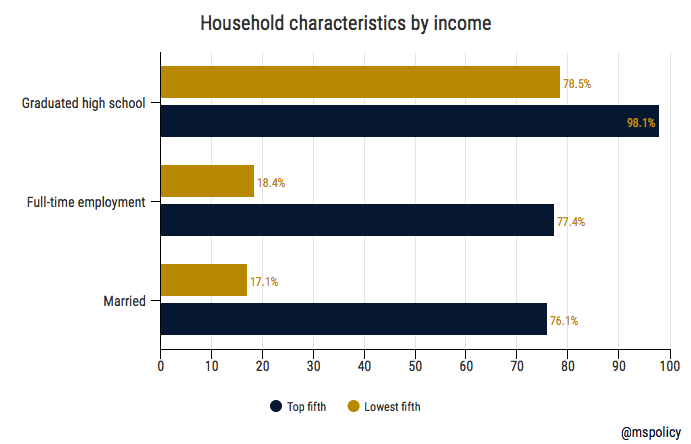
Of the lowest fifth earners in our country, those with an income range of up to $24,638:
- 21.5 percent did not receive a high school diploma.
- 18.4 percent of householders worked full-time. 68.5 percent did not work.
- 17.1 percent are married couple families compared to 82.9 percent who are either single-parent families or single.
Of the top fifth, those who earn more than $126,855:
- 1.9 percent did not receive a high school diploma.
- 77.4 percent of householders worked full-time.
- 76.1 percent are married couples compared to 23.9 percent who are either single-parent families or single.
Many things in life can dictate one’s income. Fortunately, when it comes to graduating high school, working, and getting married before children, each individual can control what path he or she takes.
Americans for Tax Reform today led a coalition of 58 conservative groups and activists, including the Mississippi Center for Public Policy, in support of the Tax Reform 2.0 legislation set to be voted on by the House of Representatives later this week.
This proposal is split into three pieces of legislation: H.R. 6760, the Protecting Family and Small Business Tax Cuts Act, H.R. 6757, the Family Savings Act, and H.R. 6756, the American Innovation Act.
Most importantly, Tax Reform 2.0 strengthens the gains made by the Tax Cuts and Jobs Act last year by making individual and small business tax cuts permanent. This tax reduction could not be made permanent when TCJA passed because of a combination of liberal obstructionism, arcane Senate rules, and an unwillingness to reduce out-of-control federal spending.
The legislation also updates retirement, education, and family savings accounts and promotes innovation and entrepreneurship for small businesses.
The full letter can be found here.
This press release is from the Americans for Tax Reform.
Dubbed the "wild west" of charter schooling by detractors, Arizona is showing that a model that provides parents with numerous choices, and bottom-up autonomy, works.
Two years ago, the National Association of Charter School Authorizers (NASCA) gave Mississippi the eighth highest score on their policy analysis of state charter laws. At the same time, Arizona came in at just 18th.
In the eyes of organizations like NASCA and others, states like Arizona do not have the necessary regulations in place concerning key issues like renewal standards, academic performance, or a default closure provision. And they don’t perform authorizer evaluations.
Mississippi took a different approach and developed a “model” charter law that was based on best practices from NASCA and similar organizations. But as we have seen, charters have been slow to open in Mississippi. Not because of lack of interest among operators or parents, but because of the process of authorizing charter schools in Mississippi.
This year, 16 different operators proposed opening a total of 17 schools across the state.The prior two years, 18 operators filed similar letters of intent to begin the charter school application process. Yet just five schools are currently opened for this school year, with one more coming in 2019.
Arizona, on the other hand, has approximately 600 schools serving north of 185,000 students. That accounts for about 20 percent of public school enrollment in the state. Deemed the “wild west” by detractors, over the past five years some 200 schools have opened with about 100 closing. Those numbers aren’t because of a law, either for better or for worse. But because parents in Arizona now recognize that they are empowered to choose the right school for their child.
Administrative attempts to shut down a public school, regardless of how poor it is doing on test scores or other measures we commonly look at, is not an easy task. You are usually met with a fierce opposition of loyal parents and potentially lawsuits as well. For the most part, Arizona parents have moved beyond that.
Arizona parents don't wait for a school to get better
They move on. It is parents who are now closing poor performing schools, not the government. Of those schools that closed, they were open on average just four years (even with a 15 year reauthorization window) and had only 62 students their final year. Without government intervention, parents were able to determine what wasn’t working.
We shy away from using words like “market” when it comes to education, but that is exactly what is happening. After all, parents have the ability to make a choice.
So it’s a different model, but how is it working? After all, our focus should be outcomes and not intention.
A review of the most recent NAEP scores among Arizona’s charter students helps to answer that question.
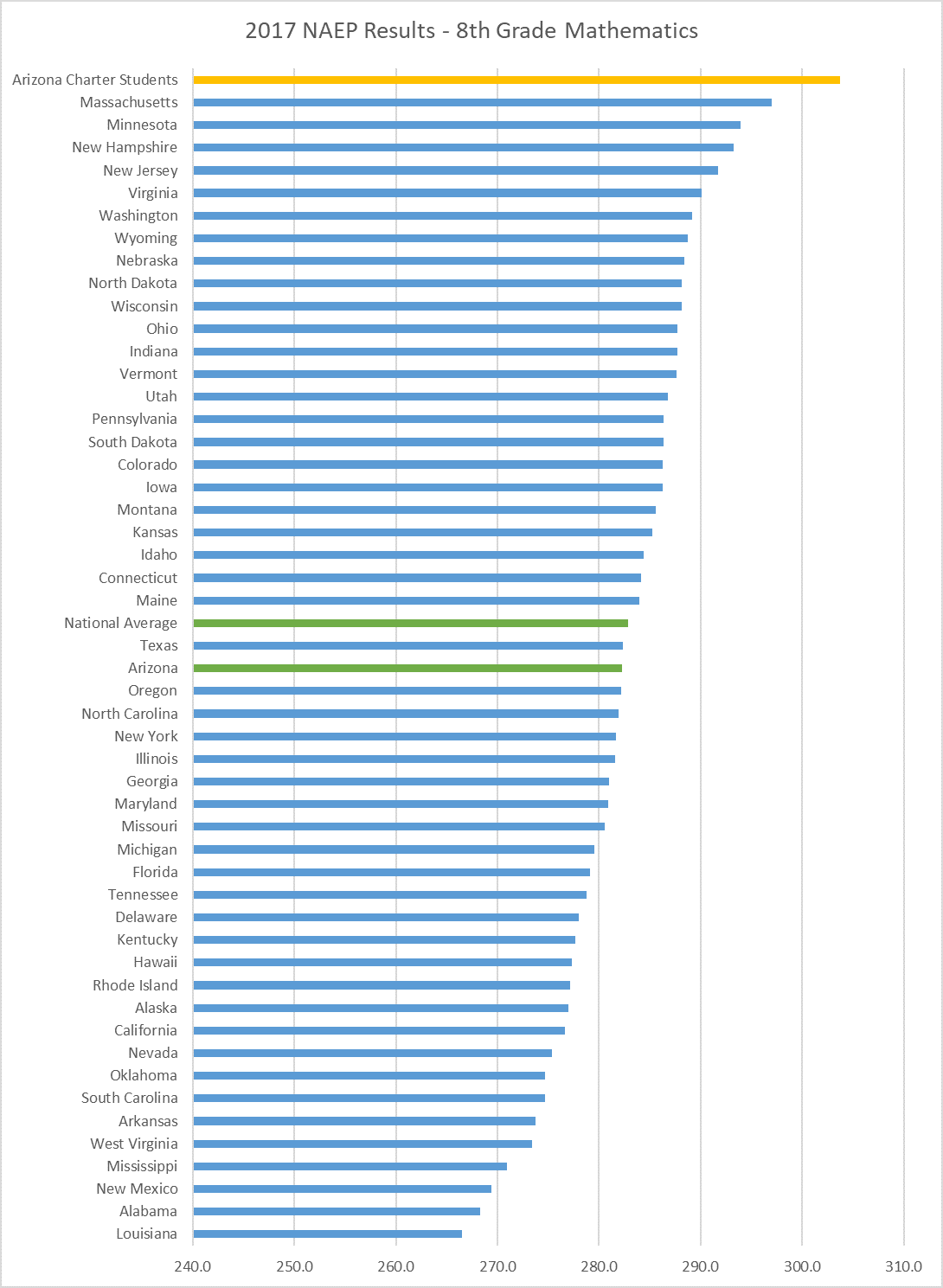
- 8th grade math was ranked first in the nation (the state rank was 25th)
- 8th grade reading ranked second in the nation, behind just Massachusetts (the state rank was 35th)
- 4th grade math was ranked 16th in the nation (the state was ranked 41st)
- 4th grade reading was ranked 16th in the nation (the state was ranked 42nd)
Beyond the overall numbers, perhaps more newsworthy, Arizona charter schools have also boosted the largest gains in the country over the past eight years among all four tests. No state showed more progress in terms of points gain between 2009 and 2017 (when Arizona charter schools are compared to the 50 individual states).
- 8th grade math had a +30 change in scale score
- 8th grade reading had a +20 change in scale score
- 4th grade math had a +11 change in scale score
- 4th grade reading had a +11 change in scale score
A couple other important points to make. While Arizona’s 8th grade students are competing with a traditional top-performing state like Massachusetts, the similarities stop there. Arizona is educating a high-minority population while Massachusetts (and similar states) are largely white. At the same time, Arizona spends about half of what Massachusetts spends per student.
Today, 84 percent of zip codes in Arizona have a charter school, the highest percentage in the country. Mississippi’s new to the charter game so it’s not a fair comparison. But that number is a rounding error in the state.
By making options available in large numbers, also known as supply, and giving power to choose to parents, also known as demand, we see a successful bottom-up accountability system.
Revenue from the first month of sports betting in Mississippi indicates a positive start for the Magnolia State.
In 2017, the legislature paved the way for sports betting should the Supreme Court overturn the restrictions on such activities, which they did this year. That allowed Mississippi to be one of the first states outside of Nevada to offer sports betting.
Through the month of August, an otherwise quiet month of the year before football season begins, casinos took in nearly $6.3 million in sports betting. This translates to more than $644,000 in revenue for casinos and $77,000 in taxes for the state.
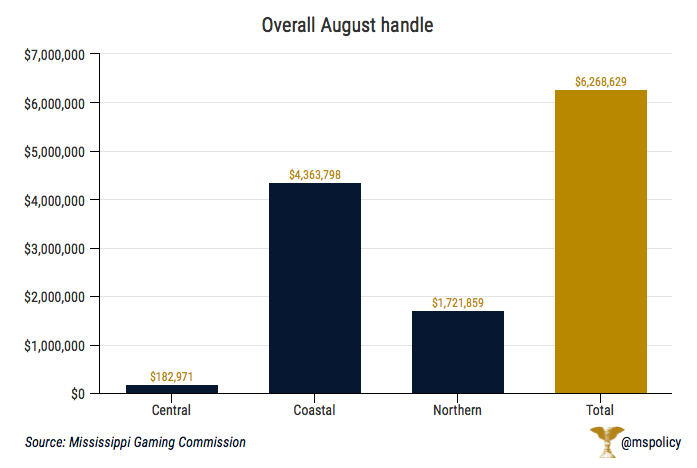
Two other important points show greater promise.
First, just 11 of the state’s 28 casinos participated in the opening month of sports betting, with many opening in the middle or end of the month.
Additionally, Mississippi casinos took in nearly $3.5 million in just the first three days of September, more than half of the handle from August. The difference? The start of college football and the NFL.
Most expect these numbers to only climb in the weeks ahead.
Mississippi added more than 14,000 jobs over the past year while the state’s unemployment rate sits at 4.8 percent, a near historic low.
Overall, the national unemployment rate sits at 3.9 percent for the month of August.
Statistically, Mississippi’s 1.6 percent over-the-year job growth compared favorably among the state’s neighbors.
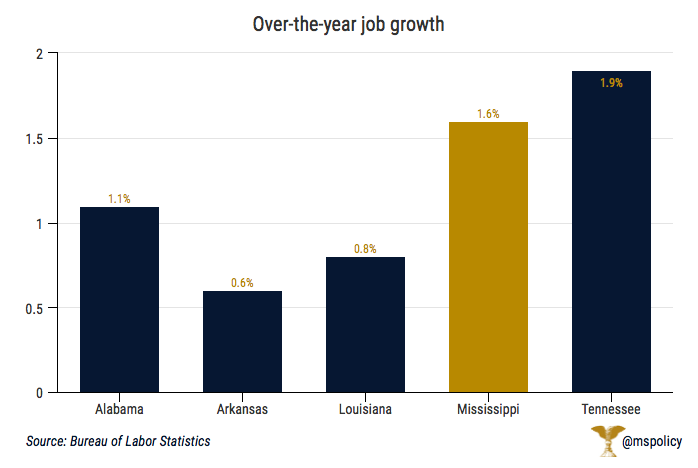
Only Tennessee, whose payrolls grew by 1.9 percent saw greater improvement in terms of job numbers, percentage wise, than Mississippi. Alabama grew by 1.1 percent while Arkansas and Louisiana grew by .6 percent and .8 percent, respectively.
Outside of Mississippi’s immediate neighbors, we saw strong gains in most SEC states, with Kentucky being an outlier among this group.
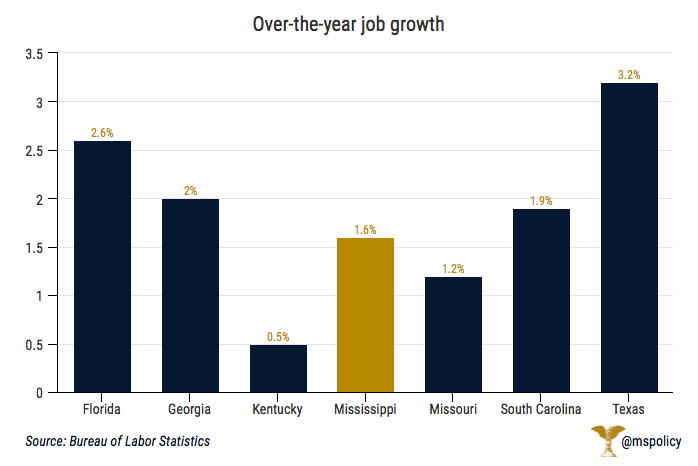
Mississippi's unemployment rate
At 4.8 percent, Mississippi’s unemployment rate remains near the state’s historic low of 4.6 percent. That occurred just this past December. But among Mississippi’s neighbors, every state but Louisiana had a lower unemployment rate.
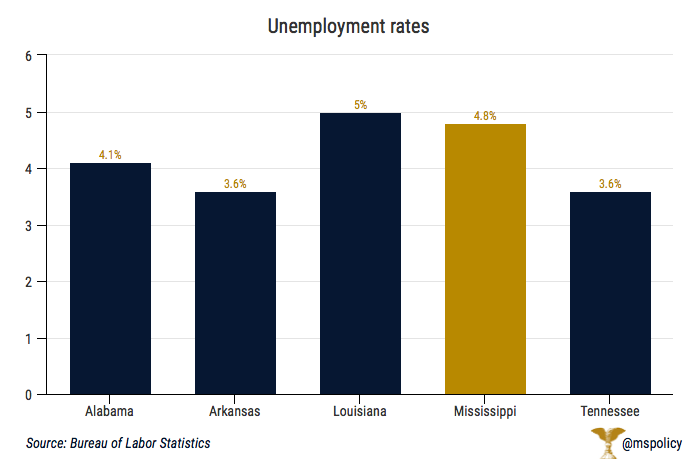
Though low, and down from just a few years ago, Mississippi’s unemployment rate is still 47th nationally.
Among the other SEC states, we see unemployment rates ranging from 3.3 percent in Missouri to 4.4 percent in Kentucky.
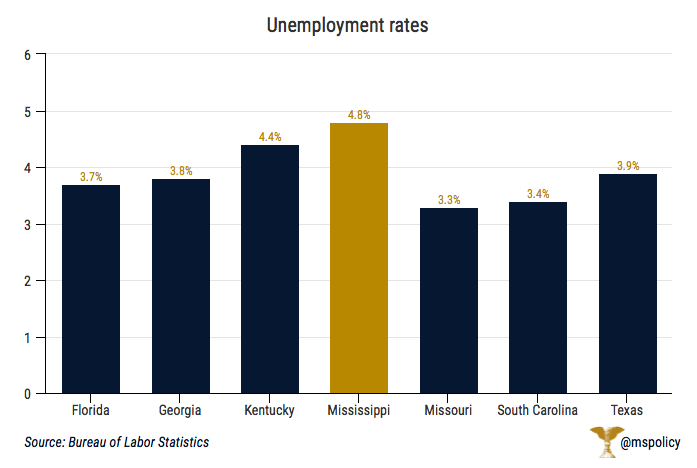
Within Mississippi, the following counties had unemployment rates under 4.2 percent (for July 2018): Rankin (3.6%), Union (3.7%), Desoto (4%), Lamar (4.1%), Madison (4.1%), and Pontotoc (4.2%). The following had unemployment rates above 9.1 percent: Humphreys (9.4%), Wilkinson (10.1%), Holmes (10.3%), Claiborne (10.8%), and Jefferson (15.2%).
Graduating from high school, obtaining employment, and getting married before having children is still the best path out of poverty.
A recent essay in the New York Times tells the story of a life in poverty. This same story could be told of countless individuals in Mississippi.
Unfortunately, something that could be productive for a larger discussion misses that mark. Under the headline, “Americans want to believe jobs are the solution to poverty. They’re not,” we learn about the struggles of Vanessa Solivan, a home health aide in New Jersey.
Vanessa is a single-mom with three children. As a home health aide, she makes between $10 and $14 per hour. She works part-time, between 20 and 30 hours a week. If we took the average of both those numbers, 25 hours a week at $12 an hour, Vanessa would make a little more than $15,000 a year. Even with the Earned Income Tax Credit, before other welfare programs, she would only be bringing in about $20,000 per year.
No one would argue that is not enough to live on, particularly with three kids. Though, Vanessa’s story isn’t quite aligned with the headline.
Full-time jobs, and a two-parent household, are the solution to poverty; not single-parents with part-time jobs
Why is Vanessa only working part-time? She wants to work more hours but can’t. Several years ago, during the Obamacare debate, Republicans rightly were arguing that these new requirements will only encourage employers to prefer part-time workers. We often talk about the law of unintended consequences when it comes to government policy, but this was a consequence you didn’t need a public policy degree in order to predict. But policy makers just chose to ignore it. Or they blamed business owners for the terrible sin of “worrying about their bottom line.”
If Vanessa were working full-time, her income would be closer to $30,000, roughly a third more income to make her household budget a little more manageable.
While there is certainly nobility in working in healthcare, if Vanessa had a better K-12 education than most who grow up in poverty, could she have been better prepared for a more sustainable career path? Perhaps if she had had access to a voucher, tax credit scholarship, or a charter school, her career would have gone in a different direction and she would have a higher income today. But alas, to most on the left, the path to better public education outcomes will only come from spending more money, despite decades of evidence to the contrary
And what about the fathers of Vanessa’s three children? One is dead from a gunshot wound after spending time in prison. The others provide occasional support, but nothing of substance. Unfortunately, this is a story that is very common in America today. Since the 1960s, when our country adopted most welfare programs in the name of a “Great Society,” out-of-wedlock birth rates have gone from about 5 percent to over 40 percent. In Mississippi, it’s 53 percent.
And disastrous results have followed
According to newly released Census data, only 17 percent of the lowest fifth income earners, those who make less than $25,000, are married. Conversely, 76 percent of the highest fifth, those with an income above $125,000, are married.
Now, if Vanessa had followed what conservatives refer to as the “success sequence,” and obtained employment and got married before having children, the New York Times writer would have had quite a different story. Even if we assume she is working the same job, and her husband enjoyed a comparable salary, the couple would be making about $48,000 per year working full-time.
The underlying message in a story like this from the New York Times is that the economy does not work for everyone. Jobs aren’t the answer. No one is dismissing the plight of those who struggle. But simply providing more welfare benefits will not move Vanessa, or others like her, off this generational cycle of poverty.
Rather, it starts with smart policy, like the Hope Act that Mississippi adopted in 2017, modeled after 1990s era “welfare-to-work” reforms. The new law requires able-bodied individuals without dependents to obtain employment or job training to continue receiving food stamps. And the path up the economic ladder includes the work of churches, non-profits, and the private sector reaching out and providing a helping hand in ways that only they can.
Those who start out in poverty certainly start out further behind. But we know there are paths to a better future. The problem is that the government, unfortunately, is usually more of a barricade than a guiding light on that path to more prosperity and opportunity.
This column appeared in the Madison County Journal on September 20, 2018.
The city of Pearl has taken a prudent approach to the city’s finances over the past 15 months, choosing to reduce spending rather than raise taxes.
For the next fiscal year, the city’s millage rate remains at 27.5 mills and the millage rate for the Pearl School District remains at 60.40 mills.
In 2017, when the current mayor and board of alderman took office, the city’s budget was around $22 million. Last year, the city trimmed it to $18.9 million.
“I knew the struggles the city was having were daily operations,” Mayor Jake Windham said. “We have good revenues. I had a gut feeling we can run a lean budget so we did our due diligence and took the most stringent route. I felt we could dig deep while still doing the necessary things.”
This year, once again, the city did not raise taxes.
“When you decline financially, it makes everything suffer,” Windham added. “We hold ourselves accountable. Raising taxes aren’t necessarily the answer. I didn’t think we had a lean budget like you have at home. We worked with city employees and department heads to create a culture of fiscal responsibility for the city. And they bought in and we were able to turn everything around. This is the first time in eight years we didn’t borrow to pay bills.”
The savings came through reviewing every dollar that was spent and making smart decisions, like implementing a purchase order system.
But this included making difficult choices.
“You can’t cut enough office supplies when you are short falling $100,000 a month,” Windham said. “We knew we had to send people home. We had 20 leave through attrition and had 15 more layoffs.”
For the next year, the budget will increase in key areas.
“As we build revenues, we concentrate on the fundaments of government, then branch out,” Windham said. “We’ve increased where necessary, including road repairs and the clean up of the community.”
The city will also incur new expenses. They are picking up the two percent increase that city employees will pay into the Public Employment Retirement System and health insurance has gone up 18 percent over the previous year.
The city is also on the hook for $800,000 for its share of the Pearl-Richland Intermodal project that will construct a bridge over the railroad tracks on South Pearson Road.
But Windham says the city is on the right track.
“We are making bond payments we weren’t and we look to come in under budget.”
This morning, a coalition of 30 free market policy groups, including the Mississippi Center for Public Policy, sent a letter to House Ways and Means Committee Chairman Kevin Brady objecting to any expansion of the federal electric vehicle tax credit.
The letter encourages Chairman Brady to reject attempts by the EV lobby and their allies in Congress to slip a tax-credit cap increase into upcoming spending packages. Congress has a responsibility to spare American taxpayers increased economic harm from a subsidy that benefits only those who can afford expensive electric vehicles.
American Energy Alliance President Thomas J. Pyle made the following statement:
“The electric vehicle tax credit subsidizes expensive vehicles that only a fraction of wealthy Americans want and that do not necessarily pollute less than modern internal combustion engines.
“Why should a typical middle class American family — with a median annual income of $44,000 — subsidize the lifestyles of the rich and famous? Political leaders should recognize that Americans can make their own decisions about how to spend their money and what cars they want to drive. We shouldn’t give handouts to wealthy individuals to help defray the cost of their luxury vehicles.”
The full letter can be found here.
This press release is from the American Energy Alliance.
The first public charter school opened in Mississippi more than two decades after our nation’s first charter school welcomed students in Minnesota. Today, five years after state legislators finally allowed charter schools to operate in our state, it is safe to say that charter approvals continue at the same snail’s pace.
The Mississippi Charter Authorizer Board recently voted to allow a new school, Ambition Prep, to open in West Jackson next year. It was the only school to be greenlighted by the state in this cycle, though two other proposals were tabled for consideration in October.
In 2018, 16 different operators proposed opening a total of 17 schools across the state from the Coast to Jackson to the Delta. The prior two years, 18 operators filed similar letters of intent to begin the charter school application process.
But when Ambition Prep opens it will be just the sixth charter school in the state, with all but one in Jackson.
Educational entrepreneurs are interested in opening schools. And parents are interested in options. Despite the small footprint, 15-20 percent of public school students in Jackson who attend a grade that is also served by a charter school are enrolled in charter schools. And that number will only increase.
Yet in light of the slow-growing sector, limited enrollment, and swelling wait lists, we wonder whose opinion matters more when it comes to educational choice – government or parents’?
Our charter law emphasizes a rigorous application process and “high quality” schools. Yet this bottleneck has created much greater pressure for early charter schools and a less dynamic and attractive environment for new operators to enter. The restriction of charter applications to D and F-rated districts most recently left the authorizer board torn between rejecting or approving an application faster than they would like to, in the event the district’s grade changes and invalidates the nearly successful proposal.
In advance of the release of school grades, state superintendent Carey Wright cautioned against judging charter schools too quickly, since they face unique start-up and environmental challenges along with the added pressure of serving students far behind academically. But the law makes this reasonable approach difficult: schools have a very narrow timeframe in which to meet certain state-determined guidelines or be shut down.
A different approach
Many years ago, Arizona took a different approach to charters than Mississippi. In Arizona, charters have a 15-year window rather than just a 5-year window to stay in business, as they do here. But most schools take far fewer than 15 years to prove their worth. And instead of the state stepping in to close poor-performing schools, parents do.
Over the past five years, more than 200 charters schools have opened in the Grand Canyon State. In the same five years, 100 other schools have closed. The average charter school that closes in Arizona is open just four years and has an average of 62 students in its final year. Parents don’t wait for the state to say if a charter is or isn’t meeting government benchmarks. They make a determination themselves. The charter sector grows according to demand, not top-down controls, ensuring that parents can make decisions about their child’s education without delay, rather than waiting for years to have a school or seat open up. Families also have many schools to choose from if one is not the right fit.
The data shows us that choice produces better student outcomes than tight government regulations.
In 2017, National Assessment of Education Progress, or NAEP, scores showed Arizona charters again performing as high as or better than traditionally top-performing states like Massachusetts, Minnesota, and New Jersey. Arizona did this while spending half of what those states spend and educating a high-minority student population.
Schools like Jackson Academy, Jackson Prep, St. Andrew’s, St Joe’s, MRA, Hartfield, and others compete for students every day. They sell themselves on why consumers, parents, should send their children to their school. And parents make decisions on where to enroll their children based on a host of reasons, ranging from academics to athletics, from values to extracurricular activities. This has created a robust private school market in the area. Why shouldn’t public schools of choice work similarly?
We’re glad leaders in Mississippi are working to create more public education options for those who want them. But the slow pace of opening charters, and the limitations on where they can be located or who can attend, is not leading to a responsive charter marketplace anytime soon. In these early stages of development, Mississippi has the opportunity to learn from other states and decide if parent demand and satisfaction should play a greater role in the charter approval process.
After all, what’s working for Arizona just might work here too.
This column appeared in The Northside Sun on September 20, 2018.
